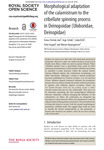Please use this identifier to cite or link to this item:
http://lib.hpu.edu.vn/handle/123456789/21863Full metadata record
| DC Field | Value | Language |
|---|---|---|
| dc.contributor.author | Joel, Anna Christin | en_US |
| dc.contributor.author | Scholz, Ingo | en_US |
| dc.contributor.author | Orth, Linda | en_US |
| dc.date.accessioned | 2016-07-04T03:48:58Z | |
| dc.date.available | 2016-07-04T03:48:58Z | |
| dc.date.issued | 2016 | en_US |
| dc.identifier.other | HPU4160350 | en_US |
| dc.identifier.uri | https://lib.hpu.edu.vn/handle/123456789/21863 | en_US |
| dc.description.abstract | Spiders are famous for their silk with fascinating mechanical properties. However, some can further produce, process and handle nano fibres, which are used as capture threads. These ‘cribellate spiders’ bear a specialized setae comb on their metatarsus (calamistrum), which modifies cribellate nano fibres to assemble a puffy structure within the capture thread. Among different species, the calamistrum morphology can differ remarkably. | en_US |
| dc.format.extent | 11 p. | en_US |
| dc.format.mimetype | application/pdf | en_US |
| dc.language.iso | en | en_US |
| dc.subject | Structural biology | en_US |
| dc.subject | Biophysics | en_US |
| dc.subject | Structural biology | en_US |
| dc.subject | Behaviour | en_US |
| dc.subject | Biomaterials | en_US |
| dc.subject | Fibre processing | en_US |
| dc.subject | Fibre extraction | en_US |
| dc.subject | Morphological adaptation | en_US |
| dc.title | Morphological adaptation of the calamistrum to the cribellate spinning process in Deinopoidae | en_US |
| dc.type | Article | en_US |
| dc.size | 797KB | en_US |
| dc.department | Education | en_US |
| Appears in Collections: | Education | |
Files in This Item:
| File | Description | Size | Format | |
|---|---|---|---|---|
| 0233_Morphologicaladaptation.pdf Restricted Access | 797.07 kB | Adobe PDF |  View/Open Request a copy |
Items in DSpace are protected by copyright, with all rights reserved, unless otherwise indicated.
